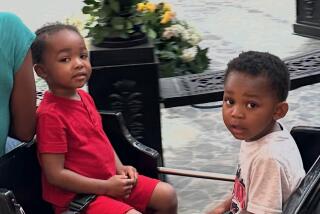Book Review : Troubled Twins in a Separate World
The Silent Twins by Marjorie Wallace: Prentice-Hall; $16.95, Hardcover; 230 pp.; illustrated
This tale of identical twin sisters, astoundingly different from other children from earliest childhood onward, arouses the compassion and curiosity of the readers from the outset.
Yet, it is biography gathered from intensive interviews with the family and acquaintances of the children, and from medical, nursing, and legal sources as well as of the writings and drawings and contacts with the twins themselves.
It is written with clarity and incisiveness by an award-winning British screen-play writer and journalist with The Sunday Times of London.
Caribbean to England
Jennifer and June, born in 1963, were reared in England, the third and fourth of five children. The father and mother had emigrated from the Caribbean as the father entered the Royal Air Force as a career noncom, an unusual chance for a black man escaping the provincialism of his homeland.
They were reported by their parents to be âfull of life as infants and small children, playing happily together,â apparently communicating with one another and eventually evolving a verbal and non-verbal language of their own which allowed them to communicate with each other to the exclusion of the rest of the family and the world. By age 3, they spoke in their strange language essentially only to each other.
For outsiders they rarely were able to put together the simplest two-or-three word sentences and even these few words were indistinct. But their parents were not greatly worried because the twins seemed happy, and black people from the Caribbean had a superstition that twins were expected to be different from other children and even supernatural. Besides, the father was preoccupied with his job, and spent little time with them because of his military travels and often times disinterest in his family.
The mother, therefore, had the oppressive burden of rearing five children virtually single-handed in a country foreign, and often forbidden to a lonely black woman.
By the earliest school years, the twins remained nearly totally aloof and silent to strangers and family, doing little school work and coming home to play together in their room for long periods of time, excluding the rest of the world, which seemed content to let them be alone.
Their parents would hear them chatter endlessly to one another and to their dolls, but could make out only an occasional word. The children grew stiff and silent when anyone in the family entered their room to see them grimacing and posturing themselves bizarrely. Their âgamesâ were unintelligible to the rest of the family. They took no part in family discussions at mealtimes, âbut bowed their heads, eyes fixed on their plates, their faces without expression, tight and drawn in denial of the world around them.â
In the rare times when they did join the family, they might laugh at a humorous occurence, but still did not speak.
Absent Father
Although the father was exasperated by their silence, his tendency was to withdraw further from his family and spend more time away from home.
During the next few years, the mother still clung to the belief that the twins would catch up and exhibit the normal speech patterns and behavior of her older children.
This never occurred as the twins became further isolated from their peers by usually being the only blacks in a white area. In addition, the girls frequently shifted schools and neighborhoods as their fatherâs occupation in the R.A.F. necessitated frequent moves. They were laughed at in class because of their silent, strange behavior, bullied and baited in the playground, and forced to cling more âtightly to the safe world of each other to strengthen the walls of their twinship and to withdraw behind them.â
What began as a curiosity of silent, withdrawn classroom behavior in the earliest grades, grew alarming to the schools when the children were between 8 and 11 years old. Their lack of speech and their high-speed âpatoisâ between themselves were only symptoms of the more serious conflict which soon dominated their lives.
Paid for by the government, special schools, speech therapists, and educational psychology and psychiatric evaluation seemed to help but little.
By the time they were 11, the battle lines were firmly drawn both against the outside world and internally, between twin and twin.
Mystery Deepens
At this point, the book begins to read even more like a mystery novel with the unpredictable, bizarre posturing twin characters acting âpossessedâ and beyond human divination in the view of many observers.
Interdependent, inseparable, and mimicking each othersâ movements, the twins seemed to look straight through family and strangers. They protected one another, yet in ensuing years sometimes fought murderously with each other with apparently little provocation, as if to destroy themselves in each other.
Of this, Jennifer confided to her diary: âJ. and I are like lovers. A love-hate relationship. She thinks I am weak. She knows not how I fear her. This makes me feel more weak. I want to be strong enough to split from her. Oh Lord help me, I am in despair. Can J. and I get back together? I really aim to be alone. Yet, even as I say this, I am deceiving myself. Can I stand being alone? I need someone to talk to, a friend. . . . My heart does not beat so fast now. It only beats fast when J. is around, always with J.â
During their teen-age years and with even less parental awareness than before, an irresistible compulsion to be involved in multiple episodes of sexual promiscuity, drug and alcohol usage, robbery and arson, brought excitement and âmeaningâ to their existence.
At the same time, they chose to steep themselves in correspondence courses in writing. Both girls, who in earlier years were poor students, became proficient in writing, compounding the unpredictable and contradictory course of their lives. The diaries, short stories, and poetry which they produced (June even attempted a novel) during their teen-age years astounded everyone.
Their writings often were brilliantly poetic in their expression of a pained psyche.
While both girls were being kept in prison awaiting trial for their wanton law-breaking, June wrote to their mother:
Here in Bristol I think of Wales.
Here where the traffic roars, I
think of the country.
Give me the little things.
Give me the mountains for the
city,
The hereafter for brambles,
The old farmhouse for these grey
puddings.
Give me sea gulls for the
crows . . . .
Diagnosis Offered
At other times their writing seemed rambling and disjointed. Their history suggests that the girls might be diagnosed as having an atypical childhood psychosis or a Childhood Onset Pervasive Developmental Disorder (another form of profound disturbance beginning in early years) each associated with elective muteness and autistic features.
However, no psychiatric diagnosis is ever complete or totally accurate when it attempts to classify the complexities of human behavior.
When looked at from a scientific point of view, the mystery of their lives diminishes and becomes a study of pathos: two children whose brains were âwired differentlyâ from the start, suffering from a rarely seen biologic defect which causes them to undergo lives of nearly total incapacitation in human relationships, yet allows them a full awareness of their societal rejection and isolation.
On a few occasions, I wondered if Wallaceâs own imagination did not inappropriately replace those of the twins.
Leaving the documented material, Wallace began to write as if she could read the minds of the girls. This created doubt within the reader as to where fact was replaced by fictionalized biography, leading to questions about the accuracy of some segments of the book. In the following passage after the girls had lit one of their fires, Wallace writes:
âThis was the kind of catharsis they had been waiting for--a purification and redemption from their suffering. The flames shrieked out for all of those years of frustration locked to another human being whose only purpose seemed to be to taunt and destroy, who although she looked identical, shared nothing but a mutual envy and disdain.â
Yet I felt it was a thoroughly researched, moving, and well-honed piece of work.
It is sad to know that the girls are at this time confined to a hospital for the criminally insane, diagnosed as psychopaths. Wallaceâs revealing work seems to plead for a kinder fate. But it seems that society can find no other place for people who are the unfortunate victims of natureâs errors.
More to Read
Sign up for our Book Club newsletter
Get the latest news, events and more from the Los Angeles Times Book Club, and help us get L.A. reading and talking.
You may occasionally receive promotional content from the Los Angeles Times.







